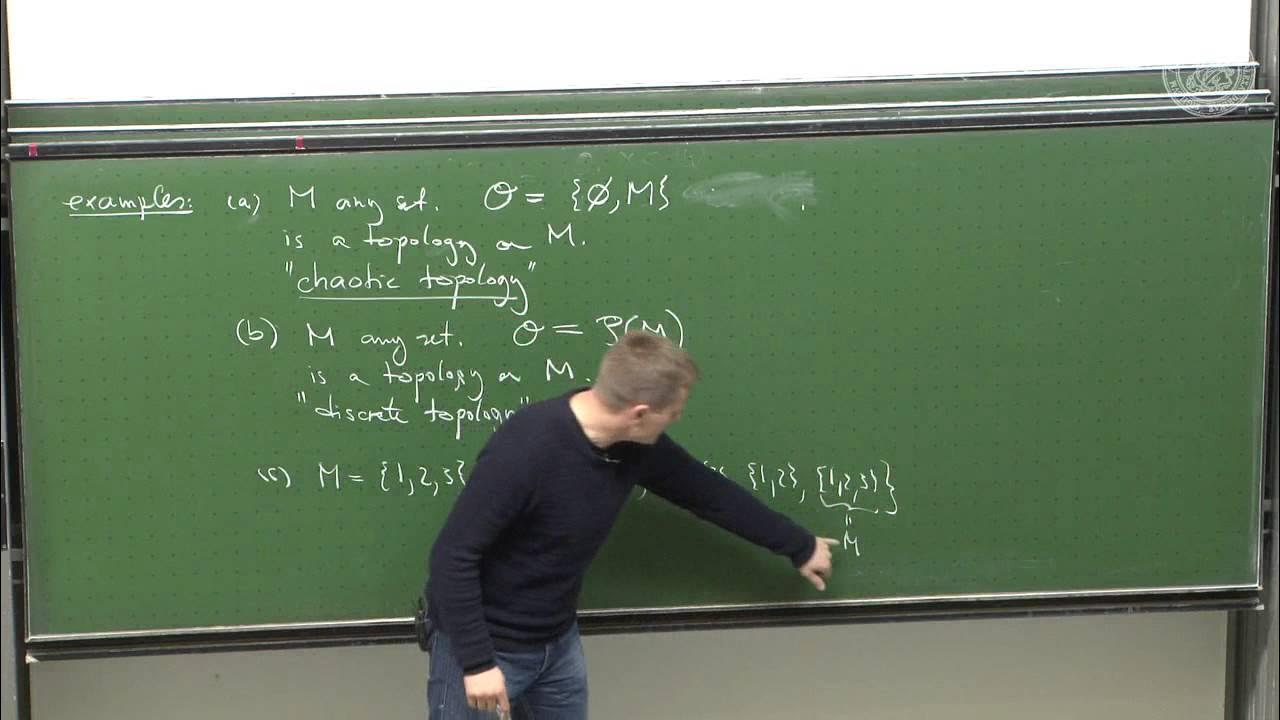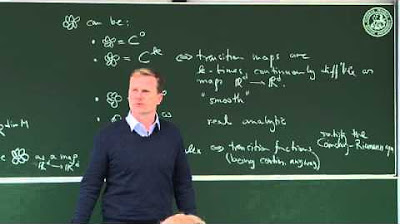What is a Topological Space?
TLDRThe video script introduces the concept of a topological space in mathematics, emphasizing its foundational role as the base for all other mathematical spaces. It compares this hierarchy to object-oriented programming's class inheritance, with topological spaces being the 'root class'. The script explores different types of spaces, such as vector spaces, metric spaces, and Hilbert spaces, highlighting how they relate to our understanding of distance, direction, and orientation. It then delves into the definition of a topological space, explaining it through set theory and providing examples of the discrete and indiscrete topologies. The video aims to clarify the abstract nature of topological spaces and their significance in mathematical studies.
Takeaways
- 🌟 Topological spaces are fundamental objects in mathematics, forming the basis for various mathematical structures.
- 📐 Vector spaces are well-known as they incorporate our intuitive understanding of distance, direction, and orientation, with examples like R³.
- 🌐 Beyond vector spaces, there are other spaces like metric spaces, function spaces, Hilbert spaces, and Sobolev spaces, each serving specific purposes in mathematics and physics.
- 🔄 Inheritance in mathematics is similar to object-oriented programming, where more specialized spaces inherit properties from more general ones, with topological spaces being the root.
- 🔢 A vector space is closed under addition and scalar multiplication, ensuring that these operations keep elements within the space.
- 📏 Metric spaces are defined by a distance function that is symmetric and satisfies our everyday notion of distance, despite potential non-geometric interpretations.
- 🔍 Topological spaces abandon geometric definitions in favor of set theory, focusing on the properties of subsets and their unions and intersections.
- 🏢 The three properties of a topological space are: the empty set and the whole set are included, the union of subsets is a subset, and the finite intersection of subsets is a subset.
- 🔎 Two 'extreme' topologies are the indiscrete topology (minimal) and the discrete topology (maximal), with most useful topologies lying between these two.
- 📚 Understanding topological spaces is crucial for exploring more complex mathematical concepts and their applications in various fields.
Q & A
What is a topological space in mathematics?
-A topological space is a fundamental concept in mathematics where it serves as the root of the hierarchy of mathematical spaces. It is a set X, together with a collection of subsets called the topology τ on X, satisfying three properties: the empty set and X are in τ; the union of any collection of subsets in τ is also in τ; and the finite intersection of subsets in τ is in τ.
How does a vector space relate to a topological space?
-A vector space is a specific type of topological space where addition and scalar multiplication are defined in a consistent way. It is an example of a more specialized space that inherits properties from the general concept of a topological space, which is at the root of all mathematical spaces.
What is a metric space and how does it differ from a vector space?
-A metric space is a set with a distance function that satisfies certain properties, such as symmetry and non-negativity. Unlike vector spaces, metric spaces do not necessarily support addition or scalar multiplication; they are primarily concerned with the concept of distance between points.
What are the three properties that define a topological space?
-The three properties that define a topological space are: 1) the empty set and the whole set are included in the topology, 2) the union of any collection of subsets in the topology is also a subset of the topology, and 3) the finite intersection of subsets in the topology is a subset of the topology.
What is the discrete topology and how does it satisfy the axioms of a topological space?
-The discrete topology is a topology where every possible subset of the set X is included in the topology. It satisfies the axioms of a topological space because the empty set and the whole set are subsets of X, any union of subsets is still a subset of X, and any finite intersection of subsets remains a subset of X.
What is the indiscrete or trivial topology and how does it work?
-The indiscrete or trivial topology is a topology where the only subsets included are the empty set and the whole set X. It satisfies the axioms of a topological space because it contains the empty set and X, any union of subsets (which can only be the empty set or X) is included, and any finite intersection of these subsets (which can only be the empty set or a single-point set) is also included.
How does the concept of a topological space relate to set theory?
-Topological spaces are defined using the language of set theory. They consist of a set X and a topology τ, which is a collection of subsets of X that satisfy the three axioms of a topological space. This means that topological spaces do not rely on geometric or distance concepts, but rather on the relationships between sets as defined by set theory.
What are some examples of specialized mathematical spaces that inherit properties from a topological space?
-Examples of specialized mathematical spaces include vector spaces, metric spaces, Hilbert spaces, and Sobolev spaces. Each of these spaces has specific properties and operations defined on them, but they all inherit the fundamental properties of being a topological space.
How does the concept of a topological space help in understanding the structure of mathematical spaces?
-The concept of a topological space provides a general framework for understanding the structure of mathematical spaces. By defining spaces in terms of sets and their relationships through the topology, mathematicians can study a wide variety of spaces with different properties without relying on specific geometric or algebraic structures.
What is the significance of the hierarchy of mathematical spaces?
-The hierarchy of mathematical spaces, with the topological space at its root, allows for a systematic study of increasingly specialized spaces. Each type of space inherits properties from more general spaces, which helps in understanding the relationships between different mathematical structures and in solving problems across various fields of mathematics.
Why is finding a middle ground between the discrete and indiscrete topologies important?
-Finding a middle ground between the discrete and indiscrete topologies is important because most mathematically useful spaces lie between these two extremes. The discrete topology offers too much structure, while the indiscrete topology offers too little. A middle ground allows for the definition of spaces with just the right amount of structure needed for specific mathematical investigations.
Outlines
📚 Introduction to Topological Spaces
This paragraph introduces the concept of a topological space in mathematics, explaining it as a fundamental object that serves as the root of the hierarchy for all other mathematical spaces. It compares this to the base object class in object-oriented programming, highlighting that vector spaces, metric spaces, Hilbert spaces, and Sobolev spaces all inherit from the topological space. The paragraph discusses the idea of mathematical objects with certain properties living inside a space, such as a quantum state within a Hilbert space, and sets the stage for further exploration of these spaces.
🔍 Understanding Topologies: Discrete and In Discrete
This paragraph delves into the specifics of creating a topology, using the example of a set with three elements (1, 2, and 3). It explains how to satisfy the three properties required for a collection of subsets to form a topological space. The paragraph introduces the concepts of the in discrete topology, where only the empty set and the whole set are included, and the discrete topology, which includes every possible subset of the set. It also discusses the importance of finding a middle ground between these two extremes for a topology to be useful in mathematical applications.
Mindmap
Keywords
💡Topological Space
💡Vector Space
💡Metric Space
💡Hilbert Space
💡Sobolev Space
💡Inheritance Hierarchy
💡Set Theory
💡Discrete Topology
💡Indiscrete Topology
💡Axiomatic Definition
Highlights
A topological space is a fundamental concept in mathematics, serving as the root of the hierarchy of mathematical spaces.
Vector spaces are well-known for capturing our intuitive understanding of distance, direction, and orientation.
Metric spaces, unlike vector spaces, do not guarantee that addition and scalar multiplication work in the usual way, but they do have a defined distance between any two points.
Hilbert spaces and Sobolev spaces are examples of specialized spaces that contain solutions to certain differential equations, used in quantum mechanics and other fields.
The concept of a topological space can be compared to object-oriented programming's class hierarchy, where all other spaces inherit properties from the topological space.
A topological space is defined using set theory, without relying on geometric definitions.
To be a topological space, a collection of subsets must satisfy three properties: the empty set and the whole set are included, any potential infinite union of subsets is included, and any finite intersection of subsets is included.
The indiscrete topology is the simplest topology where only the empty set and the whole set are included in the topology, satisfying all three axioms.
The discrete topology includes every possible subset of the given set, representing the largest possible topology for a space.
The choice of topology is crucial for a space to be mathematically useful, with most interesting dynamics occurring between the extremes of indiscrete and discrete topologies.
The concept of a topological space is the starting point for exploring more complex and fascinating topics in topology.
The video aims to provide a basic understanding of topological spaces and their significance in mathematics.
The analogy of the base object class in programming helps to understand the foundational role of topological spaces in mathematical structures.
In metric spaces, the distance between two points is symmetric, meaning it's the same regardless of the starting point.
Examples like the power set illustrate how the discrete topology can include a vast number of subsets, fulfilling the axioms of a topological space.
The video provides a clear and concise explanation of topological spaces, suitable for those new to the concept.
Transcripts
Browse More Related Video

Topological spaces - construction and purpose - Lec 04 - Frederic Schuller

Understanding Vector Spaces

Differentiable structures definition and classification - Lec 07 - Frederic Schuller

Learn Topology in 5 minutes (joke video)

Tensors for Beginners 15: Tensor Product Spaces

Tensor space theory I: over a field - Lec 08 - Frederic P Schuller
5.0 / 5 (0 votes)
Thanks for rating: